The rise of fast fashion resulted in a tidal wave of clothing in the world’s…
The post Best of Earth911 Podcast: Wearwell Cofounder Erin Houston Builds Circular Clothing Lifestyles appeared first on Earth911.

The rise of fast fashion resulted in a tidal wave of clothing in the world’s…
The post Best of Earth911 Podcast: Wearwell Cofounder Erin Houston Builds Circular Clothing Lifestyles appeared first on Earth911.
Mansur Arief never imagined himself working in mining. As an artificial intelligence researcher finishing a PhD at Carnegie Mellon University, he developed safety algorithms for self-driving cars. But then he took a postdoctoral position at Stanford University, where he met Jef Caers, the director of the new research program Mineral-X. Caers’ program seeks to reinvent mining for the clean energy economy by using advanced data science tools to help companies find and extract critical minerals like lithium in a more sustainable manner — and by developing protocols to engage local communities at the exploration phase, so they can decide whether or not new mining should be permitted on their land.
Arief was fascinated to discover that his skillset — developing AI algorithms that make complex decisions from real-world data — could be applied to searching for the minerals desperately needed to build out clean energy technology. (From 2017 to 2022, demand for nickel and lithium, which are essential components in the batteries that power electric vehicles, jumped by 40 percent and 300 percent, respectively.) He’s currently involved in a Mineral-X project focused on the strategic design of critical mineral supply chains for the United States. Eventually he hopes to take on a larger role in another early-stage project that aims to reduce the mining sector’s carbon footprint in his home country, Indonesia.
“I believe this is a new field that requires lots of attention, and it has huge potential moving forward,” Arief told Grist.
However, Arief’s interest in mining makes him an outlier among young professionals. In the U.S., as well as other mining powerhouses like Australia and Canada, the mining industry is facing an unprecedented workforce crisis as today’s youth choose not to pursue careers in a sector they see as stagnant, hidebound, and out of touch with their values. Enrollment in university programs that train mining experts is cratering, and companies are struggling to attract new talent to replace their aging staff. The blue collar mining workforce of drillers, machine operators, and others who actually extract the minerals faces challenges, too. To beef up domestic critical minerals mining, the U.S. will likely need more of these laborers. It remains to be seen whether there are enough young people willing to replace mine workers on the brink of retirement today, much less grow the workforce to meet skyrocketing demand.
“Mining, and anything related to mining right now, is less attractive on average to young people,” Jim Faulds, who directs the Nevada Bureau of Mines and Geology, told Grist.
The mining industry’s poor reputation has arguably been earned. In many parts of the world, the industry has devastated local ecosystems, upended Indigenous communities, and exploited its workers. Yet in order to meet international targets for slowing climate change, the world needs enormous amounts of lithium, cobalt, copper, nickel, and other metals that are key ingredients in clean energy technologies. Securing these commodities could mean opening hundreds of new mines worldwide.
To meet this need, the industry is racing to address shortages of young experts with the technical skills needed to discover mineral deposits, develop mines, and operate extraction sites. That includes the geoscientists who identify and characterize mineral deposits to help companies determine if they are economical to mine, the mining engineers who determine the best way to get mineral-rich rocks out of the ground, and the metallurgists tasked with separating minerals of interest, like cobalt, from everything else inside those rocks. Across each of these specialized fields, Faulds said, the mining industry is feeling a workforce squeeze.
New workers “are getting scooped up immediately,” he added.
That sort of hiring demand, Faulds said, usually translates to increased enrollment in the technical training programs that churn out these professionals. But that’s not what’s happening. According to the American Geosciences Institute, a nonprofit umbrella organization for geoscience professional associations, 27 percent of the existing geosciences workforce is expected to retire by 2029. Without enough new graduates to replace them, the organization projects a shortage of approximately 130,000 workers by the same year.
Not all of those lost geoscientists would have worked in mining. But given that the number of students completing degrees in mining disciplines has been falling for years — alongside the number of new faculty hires and university mining programs — experts believe a talent shortage is coming into view.
“Anecdotally, I expect there to be a shortage [of economic geologists] in the near future if not already,” Graham Lederer, a researcher with the U.S. Geological Survey’s Geology, Energy, and Minerals Science Center in Reston, Virginia, told Grist. “Mining engineering and extractive metallurgy are facing similar, if not more severe, workforce issues.”
Indeed, the number of mining engineering degrees awarded in the U.S. has fallen 39 percent since 2016, according to a 2023 report by the consulting firm McKinsey & Company, while the number of mining and mineral engineering programs nationwide has fallen from 25 in 1982 to just 14 today. The trends are so stark that Deborah Ross, a member of Congress representing central North Carolina, raised the problem at a recent Congressional hearing on establishing domestic supply chains of critical minerals, noting “we’ll likely not have the workforce … to fulfill our national mineral needs.” Earlier this month, the National Academies of Sciences hosted a workshop to discuss how the U.S. can meet the workforce needs of the domestic minerals sector.
The problem isn’t limited to the U.S. Australia is the world’s top producer of the lithium needed for electric vehicle batteries, but interest in mining engineering has plunged even more precipitously there, with program enrollment falling 63 percent since 2014. In Canada, a top producer of the battery metal nickel, 70 percent of young people who responded to a recent poll said that they “probably” or “definitely” wouldn’t consider a career in mining — higher than the percentage who said they wouldn’t consider careers in oil and gas. The UK’s mining workforce is also aging fast: According to a 2022 report by the nation’s Mining Education Forum, a staggering 80 percent of mining and mineral processing engineers are now over the age of 50.
There are a host of reasons mining has lost its luster. But a key factor experts emphasized in interviews with Grist is the industry’s reputation for polluting the planet and exploiting its workers, in a quest to dig up things we either don’t need or that are actively harmful.
“The mining industry keeps mining coal and diamonds and gold to make money,” Caers, the Mineral-X director, told Grist. “People don’t want to get involved in that.”
A mining engineer by training, Caers cut all ties with the oil and gas sector in 2022 to focus on critical minerals for the energy transition. He believes new technology, combined with strong environmental stewardship and socially responsible development, is key to reinvigorating youth interest in mining. Many of the students Caers works with, like Arief, have a background in computer science or artificial intelligence, and are now learning how their skills can be used to help locate new deposits of critical minerals in the enormous datasets collected by geologists.
“There is, in fact, a lot of interest in critical minerals, and there’s lots of interest in using new technology,” Caers said. “But the mining industry doesn’t tap into that enthusiasm.”
In addition to failing to prioritize critical minerals extraction over cash-cow commodities like gold, Caers feels that the industry at large isn’t advertising itself enough on university campuses like Stanford, which have a large number of tech-savvy students who want to work on climate solutions.
A few startups are bucking the trend. The most prominent is KoBold Metals, a Bill Gates-backed minerals exploration company and Silicon Valley’s first mining unicorn, a term for a privately held startup valued at over a billion dollars. KoBold, an industrial affiliate of Mineral-X that has financially backed the latter and collaborated on its research, is developing machine learning and artificial intelligence tools to scour the Earth’s crust for new deposits of lithium, copper, cobalt, and nickel. Its staff of about 200 employees includes roughly equal numbers of geoscientists, data scientists, and software engineers, according to KoBold president Josh Goldman. While a few years back recruiters at KoBold might have needed to spend a lot of time explaining why the company’s mission mattered, today “it’s in the zeitgeist,” according to Goldman.
“Everybody’s worried about lithium supply, everybody’s worried about copper,” he added.
Goldman acknowledged that potential young hires often have “some hitches about joining a mining company.” But he said KoBold is typically able to assuage their concerns by explaining its ethical principles, which include only doing exploration and extraction in places where it can get strong community buy-in. “That is a very frequent topic of conversation,” Goldman said.

Another startup that’s bringing young people into the mining sector is Nth Cycle. It works with both mining and recycling companies to extract critical minerals from scrap metal, electronic waste, and mine waste using its novel “electro-extraction” technology, which replaces traditional high-heat smelting with an electricity-driven filtration process to separate and refine metals. Company founder and CEO Megan O’Connor says that the company’s 35-person staff is composed mainly of fresh-out-of-college engineers who “never thought that they would ever be in mining.” But Nth Cycle’s mission of developing more sustainable approaches to extracting and recycling the metals needed for the clean energy transition struck a chord with them.
“We are sustainability [and] circular-economy-related, but focus on doing that for the mining industry,” O’Connor told Grist. (O’Connor was a 2022 Grist Fixer.) “That’s definitely how we’ve seen people get excited.”
But these startups are the exception rather than the norm in an industry dominated by large multinational firms that mine a wide variety of commodities worldwide and tend to adhere to local labor and environmental standards, even when those standards are poor. And it remains to be seen whether the broader mining industry can clean up its act enough to attract the young talent needed to support the energy transition — especially in more traditional fields like economic geology and mining engineering.
Finding top-tier geologists with years of experience in mineral exploration “is pretty difficult already,” Goldman said, citing a “talent drain” from the industry in the 2010s when new, high-quality discoveries dwindled and major mining companies reduced their exploration efforts. As KoBold begins to develop its first mine — an underground copper and cobalt mine in Zambia — it’s already struggling to find local experts with the skills to design and build it, Goldman said.
“For us, it’s important not to just have global talent in mine design and mine building, but Zambian talent in leading that project,” Goldman said. But with the nation not having built a large new underground mine in decades, “that’s really hard.”
As hiring challenges loom in the U.S. as well, lawmakers are stepping in to try to bolster the nation’s workforce: A provision in the 2022 CHIPS and Science Act calls on the National Science Foundation to make new funding opportunities available to train undergraduate and graduate students in mining engineering, while a bipartisan bill introduced in the Senate last year, the Mining Schools Act of 2023, would require the Department of Energy establish a grant program to support domestic mining education. (The bill hasn’t passed out of committee yet.) Faulds, of the Nevada Bureau of Mines and Geology, called the Mining Schools Act “a start” but warned that the $10 million in funds the bill authorizes every year for eight years isn’t a “huge amount” when spread across the entire country.
In addition to technical experts, the mining industry will need blue collar workers to support additional critical minerals extraction. Today, there are approximately 375,000 people working in the minerals mining sector and another 97,000 working in coal mining in the U.S., according to Conor Bernstein, a spokesperson for the National Mining Association. Many of those workers are employed in jobs like construction, drilling, trucking, ore processing, and equipment maintenance. If the U.S. is going to ramp up production of critical minerals, this blue collar workforce will likely need to grow, although exactly how much will depend on technology trends and domestic mining policy.
“However you game the estimates … the number of blue collar workers our industry will need in the coming years is poised to increase,” Bernstein told Grist.
At the same time, the mining sector will face widespread retirements by the late 2020s, according to a 2014 report by the Society for Mining, Metallurgy, and Exploration. “The challenges identified in that report have now collided with surging mineral demand driven by the energy transition,” Bernstein added.
Whether the industry will have the same difficulties finding young people to work blue collar mining jobs that it faces recruiting technical experts is unclear. But there are other trends at play that could help critical minerals companies find the workers they need: The U.S. coal industry has been cratering for years, creating an economic void that needs to be filled in coal communities nationwide. Many of the coal miners now facing layoffs or early retirements could be retrained to work in lithium or nickel mining or processing, said Erin Bates, the communications director for United Mine Workers of America, which represents more coal miners than any other North American union.
“A lot of these coal miners have massive skill sets,” Bates said. “They learn so much in the coal mine, that any other job they move into in that realm … they will be able to learn.”
This story was originally published by Grist with the headline The climate case for a career in mining on Jan 31, 2024.
This coverage is made possible through a partnership with Grist and Interlochen Public Radio in Northern Michigan.
On a Sunday morning in Charlevoix, a small town surrounded by lakes in northern Michigan, people gathered in the Greensky Hill Indian United Methodist Church. The small, one-room log building is almost 200 years old and the hymns are sung in English and Anishinaabemowin.
It was December, so Pastor Johnathan Mays was leading an Advent service, one of his last, since he would soon retire. In between reflections on scripture, Mays touched on an important venture: The church is planning to install solar panels on their larger meeting hall, working with Michigan-based nonprofit Solar Faithful to do so.
Greensky Hill has a long history of environmental care and stewardship, grounded in Anishinaabe culture, with a majority Native congregation.
One of the ministry’s priorities is the “greening of Greensky Hill.”
Mays said that prompts them to ask “how we can use our space and our resources to address those issues for climate care, or creation care, or what some people call Earthkeeping?”
As Greensky Hill works to become more sustainable, it’s switching from propane to heat pumps to become more energy efficient. Mays said solar will allow them to use renewable energy and give that energy back to the grid.
“The biggest issue was how can we get this huge building off of greenhouse gas creation?” he said, referring to the meeting hall, which was built in the 1990s.
Across the country, houses of worship are pursuing solar systems.
As of 2021, about 2 percent of houses of worship in the United States have solar systems, according to Lawrence Berkeley National Laboratory, which the University of California manages for the U.S. Department of Energy. That’s disproportionately high; houses of worship make up only 0.6 percent of all non-residential buildings.

But these projects can be difficult to execute. Congregations can have tight budgets, older buildings and more pressing priorities. And switching energy systems can mean a lot of bureaucratic paperwork for which they might not have the staff.
And, because houses of worship generally don’t pay taxes, they’ve also had trouble capitalizing on renewable energy tax benefits.
One alternative has been for them to work with third parties that could benefit from the tax credits. For instance, an investor could buy and install solar panels on a church. The church would buy that power from the investor, but wouldn’t own the panels — an arrangement called a power purchase agreement.
Now, they have another option. The federal Inflation Reduction Act has made it possible for governments and tax-exempt entities, including houses of worship, to get tax credits for renewable projects. Called direct pay, the program provides them with a tax credit worth up to 30 percent of the installation cost. That can help cover some expenses, and advocates say it’s critical to getting more congregations to consider solar.
“I expect in the coming year, it’s really going to boom, the solar on houses of worship,” said Sarah Paulos, the programs director for Interfaith Power and Light. “It makes a lot of sense. If they can cut their utility bill way back, then they have more money to do what they’re there for, which is their mission.”
Interfaith Power and Light might sound like a local utility (or maybe a prayer group) but it’s actually a national network focused on climate action and religion, started in 1998 as a coalition of Episcopal churches that worked together to buy renewable energy. It has since expanded to other denominations and faiths.
Paulos has worked in this field for almost 20 years. She said when she started, there were a lot of climate deniers, especially in churches.
“In the beginning, people of faith were really, really being courageous and stepping out and talking about responding to climate change through renewable energy and energy efficiency as a moral call to care for creation,” she said.
While there’s increasing acceptance that climate change is happening, religious Americans are still far from unified in their views.
A 2022 Pew Research Center survey found that most religious adults believed they should protect the Earth. But for a variety of reasons, highly religious people tend to be less concerned about climate change than other adults in the U.S.
One way to reach people and engage them in climate action is through tangible efforts like solar, said Leah Wiste, the executive director of Michigan Interfaith Power and Light.
“In the public conversation, I think we’ve kind of failed to see the leadership that people of faith and conscience are taking on these issues,” she said.
Local involvement is critical to getting more people to install solar and non-residential buildings – such as schools or houses of worship – are part of that.
A study published last November in the journal Frontiers in Sustainable Energy Policy found that when non-residential buildings install solar, they can spur other installations in the area.
But raising awareness of solar doesn’t necessarily make it more equitable.
The researchers say it’s unclear how effective houses of worship can be in encouraging more solar in their communities “without directly addressing low-income barriers to solar adoption,” like budget constraints and lower home ownership rates.
And houses of worship with solar are located disproportionately in “relatively wealthy, white and educated census tracts,” according to Berkeley Lab, mirroring the broader trend.
Still, many people working at the intersection of religion and renewables say these projects are an opportunity for more people in those communities to learn about solar.
“Part of that can happen just through the simple physical act of putting a system on the roof,” said Galen Barbose, a scientist at Berkeley Lab. “But houses of worship are also in a unique position to be able to sponsor events, talk to their membership, and potentially really serve as emissaries for solar energy.”
Rob Rafson has worked to put solar panels on churches for years. He’s the president of the solar energy company Chart House Energy.
About a year ago, Chart House Energy teamed up with the Climate Witness Project, Michigan Interfaith Power and Light, and climate activists in the Detroit area to launch Solar Faithful.
Rafson wanted to make it easier for houses of worship to adopt solar.
“It’s been a very big challenge,” Rafson said. “Because churches — they’re nonprofits, they don’t have a budget, they don’t want to borrow money, and the size project… is too small for investors to invest in.”
Despite such challenges, congregations have managed to install panels. At the First Lutheran Church in Muskegon, a new solar array shines on the roof.
“They’re hard to see,” said Pastor Bill Uetricht. He’s walking around the church, craning his neck, trying to get a good view of the panels. “You can see that it’s on about half of that roof up there.”
Now that it has solar panels, the church needs to buy less power from utilities. That’s expected to lower the energy bill.
It’s an example of a power purchase agreement. By purchasing the solar-powered energy, First Lutheran will pay off the project cost of around $175,000 to an investor. Buying the power from their own array, they’re slowly paying back their investor. Once that’s done, the power that comes from the array is essentially free.

Uetricht said First Lutheran got involved with solar when a couple in the congregation gave the church two panels they didn’t know what to do with.
“I contacted a cousin of mine who works in alternative energy, and I said, ‘Hey, send me to someplace where I can do something with these two panels,’” Uetricht said.
They ended up working with Solar Faithful.
Uetricht said installing solar panels is one way of fulfilling their mission. He said that the world doesn’t belong to us, but that it is a gift – one that we haven’t been caring for.
“Old technologies have contributed to that lack of care,” he said. “So it only makes sense that we would be at the forefront of encouraging alternative energy sources.”
This story was originally published by Grist with the headline Across the country, houses of worship are going solar on Jan 31, 2024.
Most of us know the value of recycling and reusing items like plastic bottles, hand-me-down…
The post The Basics of Recycling Scrap Metal for Money appeared first on Earth911.
China is both the world leader in renewable energy and coal production, but installed solar and wind capacity are projected to surpass coal in the country for the first time in 2024, industry association China Electricity Council (CEC) said in its annual report, as Mining.com reported.
According to the report, by the end of this year, solar and wind will supply approximately 40 percent of installed capacity, while coal will make up 37 percent.
“Clean energy contributed a record 11.4tn yuan ($1.6tn) to China’s economy in 2023, accounting for all of the growth in investment and a larger share of economic growth than any other sector,” a recent analysis by Carbon Brief said.
At the end of last year, solar and wind made up roughly 36 percent of China’s energy capacity, with coal at just below 40 percent, reported Reuters.
“If coal interests fail to stall the expansion of China’s wind and solar capacity, then low-carbon energy growth would be sufficient to cover rising electricity demand beyond 2024. This would push fossil fuel use – and emissions – into an extended period of structural decline,” Carbon Brief explained previously.
By the end of the year, the CEC predicts China will have built approximately 1,300 gigawatts (GW) of solar and wind capacity, exceeding its official 1,200 GW by 2030 goal, The Business Times reported.
“For the first time – the rate of low-carbon energy expansion is now sufficient to not only meet, but exceed the average annual increase in China’s demand for electricity overall,” Carbon Brief said previously. “In addition, record additions of low-carbon energy deployment have been accompanied by rapid expansion in related manufacturing capacity.”
The CEC added that all China’s renewable sources of electricity — including hydropower and nuclear — accounted for more than half of total capacity for the first time last year, reported The Business Times.
Electricity consumption in the country is projected to increase by six percent in 2024, the CEC said, down from 6.7 percent last year.
China also saw its electric vehicle (EV) production grow by 36 percent year-on-year to 9.6m units in 2023. EVs now make up 32 percent of all vehicles made in the country, according to Carbon Brief’s new analysis.
“The growing importance of these new industries gives China a significant economic stake in the global transition to clean-energy technologies. Yet it also poses questions for overseas policymakers attempting to tie their own climate strategies to domestic industrial growth,” Carbon Brief said.
The post Solar and Wind Capacity Predicted to Overtake Coal in China in 2024 appeared first on EcoWatch.
The EU has drafted rules that will require companies linked to microplastic pollution to partially pay for cleanup. Companies will have to pay at least 80% of microplastic recovery costs, while the government will subsidize the rest.
The proposed plan identifies specific industries that would need to help pay for the cleanup, also known as quaternary treatment. The industries outlined include cosmetics and pharmaceuticals.
According to the EU, the drafted rule would be the first time the “polluter pays” principle would be enacted in the water sector, and the goal is to place the financial responsibility primarily on those responsible for pollution, rather than drawing money from public funds to pay for cleanups.
“With the agreement reached today, we ensure not only cleaner water for all Europeans but so much more — better access to sanitation, implementation of the polluter pays principle and energy autonomy,” Virginijus Sinkevičius, Commissioner for Environment, Oceans and Fisheries, said in a statement. “These changes will completely revolutionise the sector and make it more resilient for decades to come.”
In September 2023, the EU took efforts toward reducing microplastic pollutants by adopting a law that phases out microplastics that have been intentionally added to products, such as microbeads or glitter in cosmetics and toys or microplastic infill material used in synthetic sports turf. According to the EU, the rule will reduce microplastic waste by half a million metric tons.
The EU is now going a step further in its mission to minimize microplastic waste by drafting rules to hold companies responsible for microplastic removal. The measures are part of the EU’s Zero Pollution Action Plan, which has set a target to reduce microplastic pollution 30% by 2030.
The latest drafted rule, which would revise the EU’s existing Urban Wastewater Treatment Directive, would also promote more monitoring for PFAS and health-related parameters — such as anti-microbial resistance or SARS-associated coronavirus (SARS-CoV) — in water.
Further, the directive plans to improve stormwater management for both small and large cities, citing heavy rainfall events linked to climate change. The plan also involves improving wastewater quality for reuse.
As for next steps, the new directive will need to be officially adopted. Once it is published in the Official Journal of the EU, the rule will take effect 20 days later.
“The deal we reached today is a breakthrough for significantly improved water management and wastewater treatment standards in Europe, especially with new rules on removing micropollutants coming from medicines and personal care products,” said Nils Torvalds, Member of the European Parliament from Finland, as reported by The Guardian. “We have ensured that the impact of this legislation on the affordability of medicines will not be disproportionate.”
The post EU Drafts ‘Polluter Pays’ Rules Requiring Companies to Pay for Microplastics Cleanup appeared first on EcoWatch.
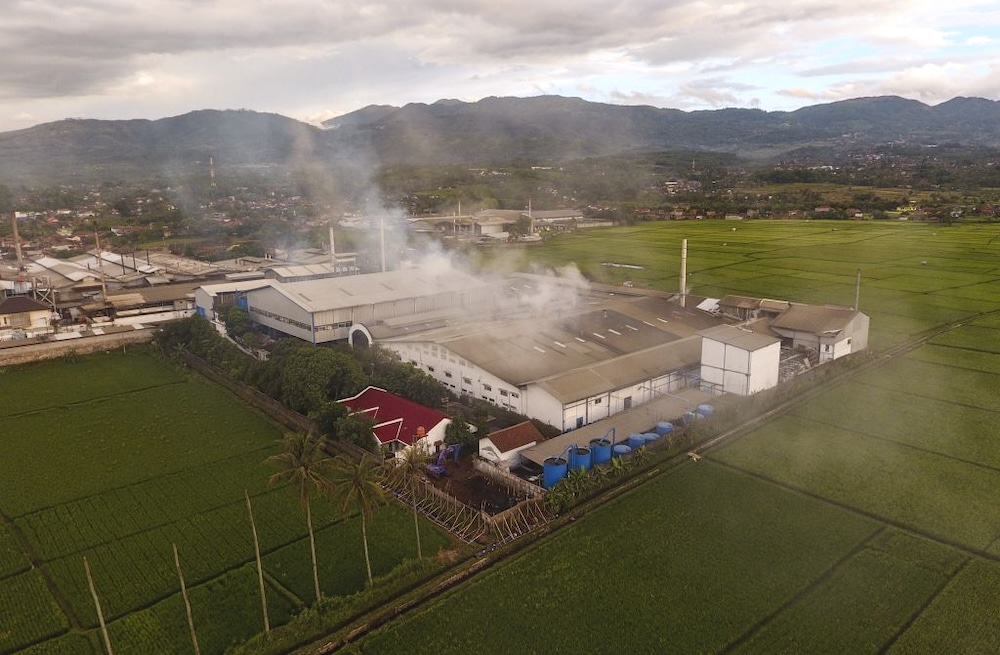
Back in 2007, design activist Kate Fletcher coined the term “slow fashion” when talking about the needs for systems-level change in the fashion industry.
It was a hat tip towards the Slow Food Movement, which began in Italy as pushback against the fast food industry, overproduction and waste, in favor of local food and traditional cuisine that supported farmers and local ecosystems.
Similarly, slow fashion aims to combat the ill effects of the fast fashion industry on supply chains, while advocating for the health of people and the environment. This happens by prioritizing the reduction in consumption, and the use of quality materials that are durable, eco-friendly and ethically sourced. Slow fashion also demands more transparency from manufacturers about supply chains.
For individual consumers, it also promotes mending damaged clothes, reusing second-hand items and upcycling to extend the life of materials to avoid having them end up in landfills.
To understand the importance of the slow fashion movement, it is important first to understand the negative impact of the fast fashion Industry.
The fast fashion industry rapidly produces high volumes of clothing that replicates trends while using low-quality, inexpensive materials.
The overconsumption of this kind of fashion leads to vast amounts of textile waste, pollution and the depletion of natural resources. Human rights violations are also prevalent, as some supply chains involve poor working conditions and extremely low pay.
The fashion industry is responsible for 8% to 10% of all global carbon emissions due to lengthy supply chains and energy-intensive production methods that create more emissions than the aviation and shipping industries combined.

The fashion industry might not be at the forefront of peoples’ minds concerning fossil fuels, but the extraction of oil leads to the creation of the plastic microfibers in most of our clothing made with synthetic materials, like polyester. The production alone of synthetic fibers accounts for 1.35% of global oil consumption.
These microfibers shed throughout usage of the clothes, especially while they are being washed, with water that ends up down the drain and reaches beaches and oceans where they can remain for hundreds of years, and be swallowed by fish and other marine life.
According to McKinsey’s 2020 State of Fashion report, fashion accounts for 20% to 35% of all the microplastic that flows into the ocean. Another study by Ocean Clean Wash found that each time we do an average load of laundry, about 9 million microfibers are released into wastewater treatment plants that cannot filter them.
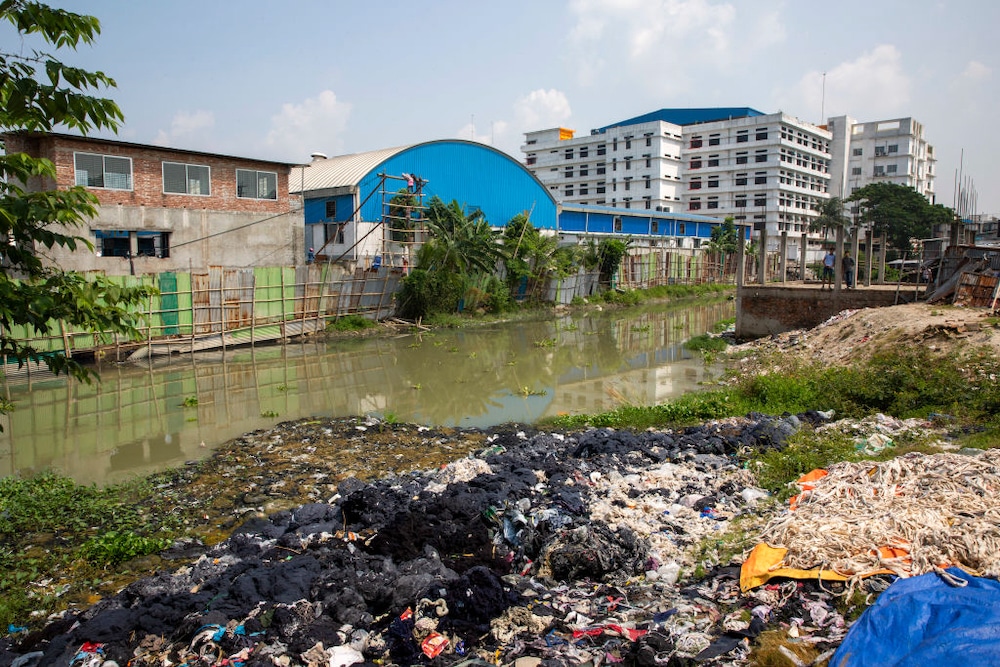
The industry is also responsible for polluted waterways from the use of fertilizers in cotton production, and usage of the chemicals in textiles factories, including lead, mercury and arsenic that end up in the factory’s wastewater, and enters local waterways surrounding the factories.
This harms both aquatic life and the health of the people living in close proximity to the water.

Concerning waste at landfills, currently 60,000 tons of clothes dumped in the Atacama Desert in Chile is detectable by satellite in space.
An estimate 92 million tons of textile waste ends up in landfills with synthetic fabrics like polyester, spandex and nylon taking anywhere from 20 to 200 years to decompose if they’re not incinerated.

Making clothes is a water-intensive process, with the fashion industry being the second-biggest polluter of freshwater resources. Every stage of the process involves vast quantities of water, from production to dyeing fabrics.
According to the UN, it takes 10,000 liters of water to produce just one pair of jeans. As of 2020, the fashion industry uses over 79 trillion liters of water a year.
In the fast fashion industry, employees are often overworked, underpaid and subject to horrible working conditions.
Companies typically outsource production to low- to middle income countries as local labor laws, free trade agreements and safety standards are often not reinforced. Factory workers earn only a little over $2 a day, with some not receiving any wages, and over 85% of these workers are primarily women of color who have no health benefits or any form of financial security.
Additionally, Unicef reports that 170 million children are engaged in child labor, and many of them are in textile production.

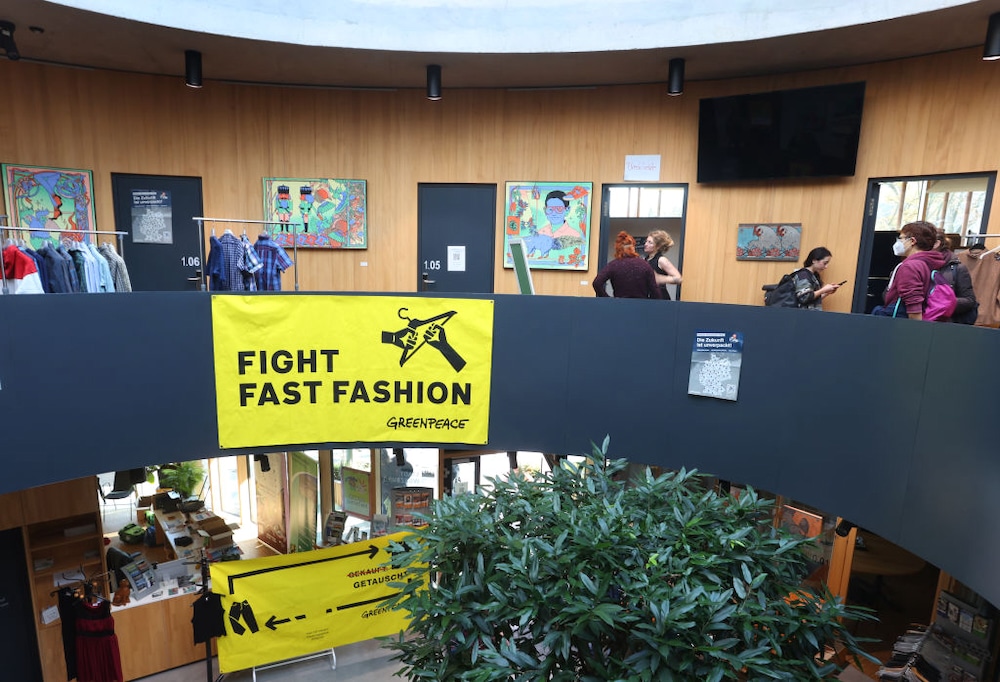
Over the last several years, movements and social media influencers have emerged to join the slow fashion movement as well as fight for workers’ rights and the environment.
The Slow Fashion Movement is an NGO that educates and empowers consumers to slow down and choose consciously.
They have thrown multiple campaigns, like Circular Fashion, You Are What You Wear (but do you know what you wear?), Know Your Leather, and Women’s Traditional Fashion that talks about clothing being a signifier of identity and culture.
The several organizations that are fighting for workers rights and fair labor conditions include the Clean Clothes Campaign, Fair Wear Foundation (which conducts independent inspections) and Fashion Revolution.
Fashion Revolution formed in the wake of the collapse of a garment factory building in Bangladesh that killed over 1000 people, and injured another 2500, after supervisors ignored a large structural crack in the building.
There is also a growing number of dynamic young influencers who are using social media platforms to spread awareness and education about fast fashion’s impacts, and help decide what to do to create a better planet.
While many are averse to paying higher prices for eco-friendly fashion, according to reports 60% of millennials prefer to shop for sustainable products, conveying that there is demand for better practices.
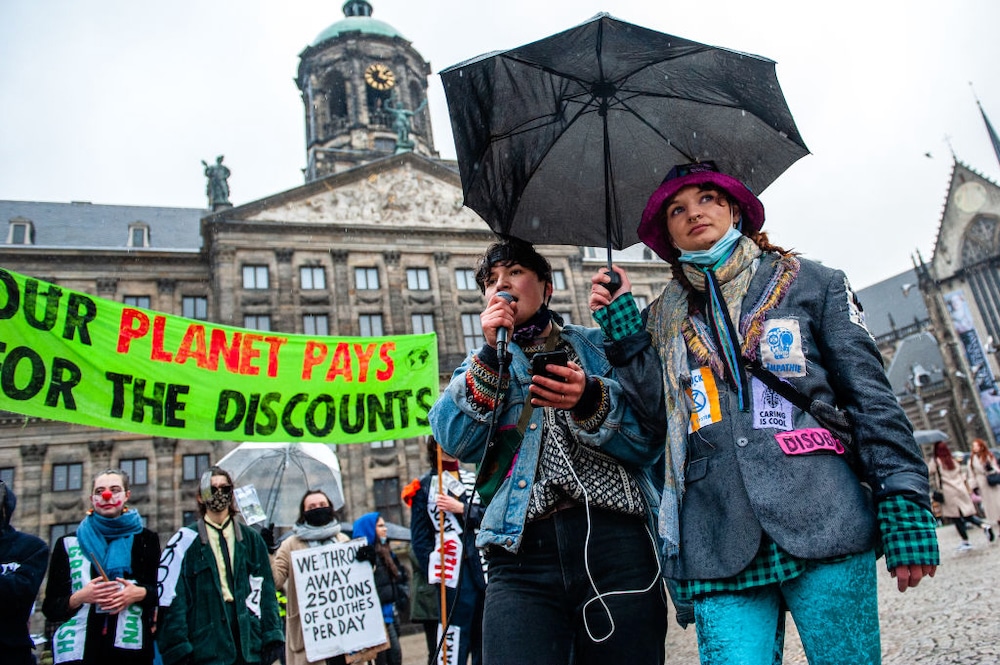
While adopting slow fashion habits can seem like a political act, given the state of the fashion industry, slow fashion habits aren’t new and have been practiced by low-income working class folks for centuries, and often out of necessity.
For those who are just starting to adopt the practice, building better habits when coming from a rushed culture of disposability involves a level of slowing down to move with more conscious intention. Here are some actions to take to adopt more slow fashion habits.
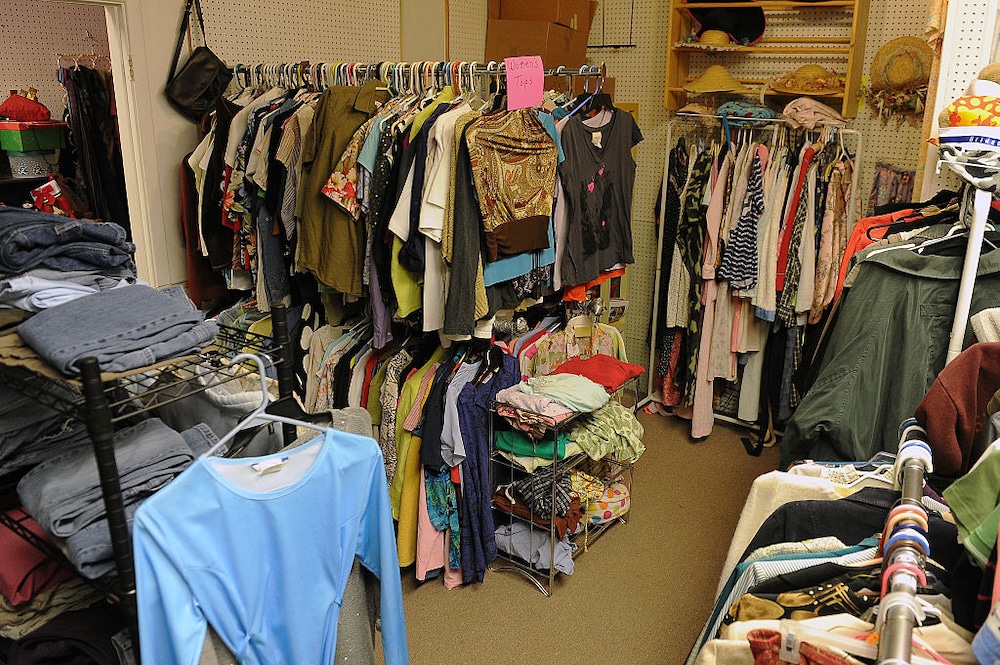
Thrifting is shopping for second-hand clothes enjoyed by a previous owner, which can be found at thrift stores, consignment shops, vintage clothing stores, as well as garage sales and flea markets. It’s a good way to contribute to a longer life for clothing items, which otherwise would go to a landfill.
Unfortunately, sometimes overwhelmed thrift stores who can’t get rid of their inventory also direct some of their clothing to the landfill. According to the EPA, 84% of that clothing ends up in landfills or is incinerated.
Prior to donating, hosting clothing swaps with friends or seeing who you might gift clothing to is another option to extend its wear.
Freecycling groups online are also good places to find or give away second-hand items. Search for your local Buy Nothing or Free Stuff groups on Facebook, or go to Freecycle.org to post or find items. Craigslist is another outlet for posting or finding free items.
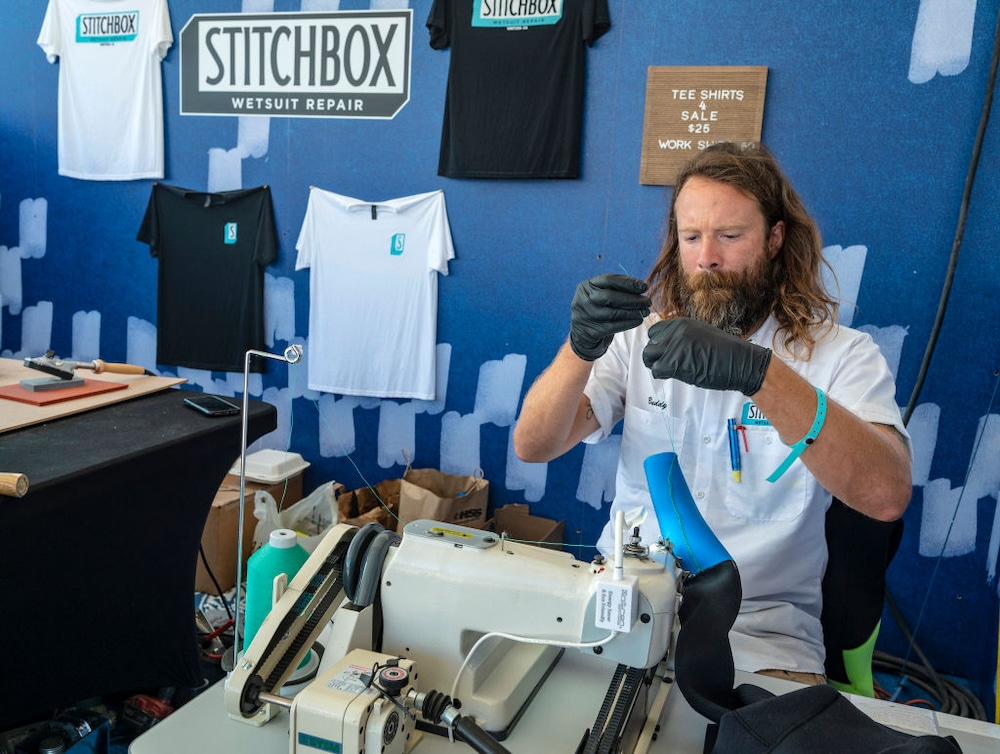
Orsola de Castro, author of the book Loved Clothes Last: How the Joy of Rewearing and Repairing Your Clothes Can Be a Revolutionary Act, writes, “We aren’t repurposing and mending clothes because we can’t afford to buy something new – we are doing it because we can’t afford to throw something away.”
For the current generations, mending clothes that have holes, stains, tears and missing buttons is not first nature like it was in previous generations that had to extend the life of their clothes out of financial necessity. Now, the typical first impulse is to throw things out.
Mending not only extends and brings new life to some items, but allows you to slow down, be meditative and also creative. There are two types of mending: visible and invisible.
Invisible mending is when the repair technique used aims for the garment to look close to its original condition.
There are several online video tutorials on how to do invisible mending.
Visible mending takes an ornamental approach to mending clothes. This involves techniques like using patches, embroidery or darning (interweaving yarn).
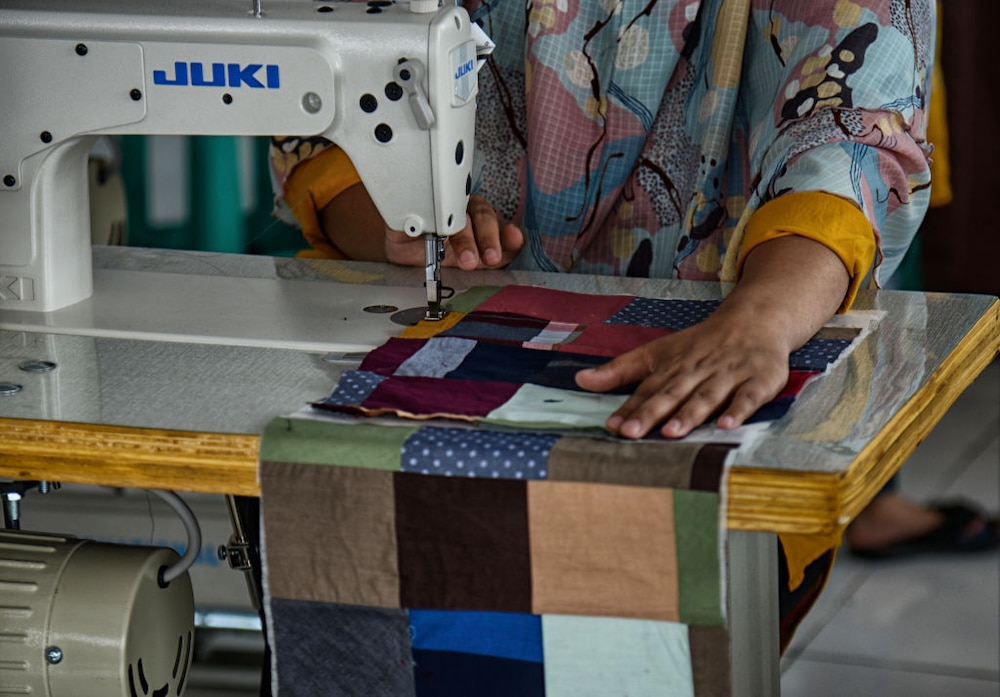
Visible mending can involve embroidering blocks, flowers, colorful patches, freestyle and satin stitching, turning clothing into wearable art.
Embroidering as mending dates back to the Edo period in Japan starting in the 1600s, and was created by the working class and fishing families to create more durable clothing.
Called sashiko, worn-out pieces would be stitched together with other pieces of fabric, to last for generations.
While there are businesses that offer tailoring, mending, repairing and altering, there are also YouTube channels to get started at home.
Some can be found here: Repair What You Wear, the Essentials Club, Blueprint DIY and Easy Sewing for Beginners.
During World War II, the British were told they would need to ration clothing, since available supplies were used to make war uniforms. This led to a large campaign to “make do and mend.”
Supplies became so scarce that women could not buy fabric and had to resort to using curtains and tablecloths to make clothes. Today, if clothes are too damaged to repair or if they have worn out their original use, another option to consider is upcycling them by repurposing them into something valuable again.
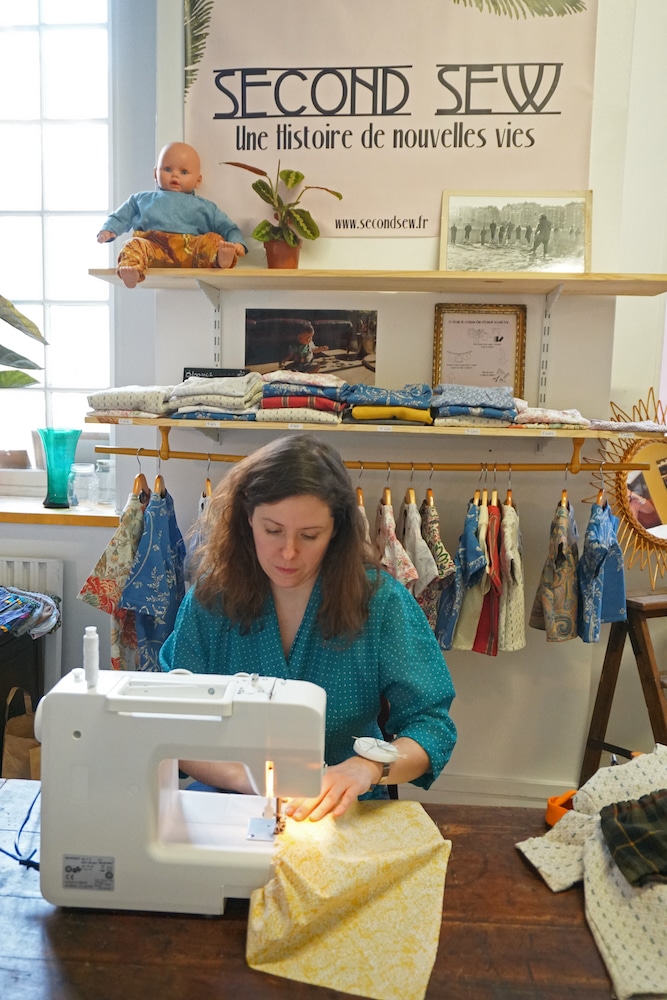
This can involve mending, but also changing the fit of clothes by cutting it down or adding more fabric. It could mean cutting up clothes and turning them into tote bags, or patches to put on other pieces of clothing. It could mean combining fabrics from two different garments to make something completely new.
It could also mean using it as fabric wrapping paper, or at the bare minimum for cleaning your house.
This also doesn’t have to stop at wearable garments, as clothing can be used to reupholster chairs, make pillow covers, tablecloths, rugs and more.
Here is a list from DIY Candy to get started.
In the 1970s, boutique owner Susie Faux got tired of seeing people spend a lot of money on items that weren’t well made, didn’t fit right and were out of season the following year, so she created what is called the capsule wardrobe.
A capsule wardrobe consists of timeless well-made garments built to last a long time, and are versatile in ways they can be worn, dressed up or down.
Over the next several decades, several designers created capsule wardrobe pieces to guide people into emphasizing quality over quantity.
Over the last few years, several campaigns and policymakers have tried to regulate the fashion industry’s impact on humans and the environment. Some have passed, others haven’t, but some are still being campaigned for.
In the EU, a grassroots campaign called Good Clothes, Fair Pay fought for living wage legislation, but legislation has yet to be passed.
In 2020, France did pass a first-of-its-kind anti-waste law to protect the environment from the amount of waste people create. The law bans stores from disposing unsold goods. Instead of being burned or scrapped, they must be recycled, redistributed or reused.
The Fashion Sustainability and Accountability Act in New York, which stalled in the House in 2022, has been reintroduced for 2023.
The key elements of the Act would involve supply chain mapping for apparel and footwear retailers that operate in New York with a global revenue of at least $100 million. They would be required to map their supply chains and subsequently address and remediate supply chain issues.
It would also require due diligence in requiring brands to identify, cease, prevent, mitigate, account for and remediate adverse impacts to human rights and the environment in their own operations. If passed, it will require brands to assess potential adverse impacts from their supply chain relationships.
It would also involve a fashion remediation fund that will consist of money by fashion sellers who have been fined.
Several states in the U.S., as well as other countries in the EU, have Extended Producer Responsibility laws, which involve producers’ responsibilities for the end lives of their products. These include take back and recycling programs as well as designing new products that are easier to reuse, repair and recycle.
Sustainable fashion can often be more expensive than other fashion due not only to higher quality materials, but also because ethical brands pay their employees living wages. Their sourcing of materials (cotton grown without pesticides, for example) often involves paying higher prices to farmers.
Looking for more affordable brands can also leave people vulnerable to greenwashing, which is when companies claim they are eco-friendly but still continue to pollute the environment.
Big brands like H&M and Decathlon have been found by regulators to have made false claims, and according to a screening of sustainability claims in the textile, garment and shoe sector, 39% could be false or deceptive.
GOTS (Global Organic Textile Standards) is one of the newer verification systems that shows that brands are using sustainably processed fabrics and organic materials. Some of those clothes carry that labeling.
In order to get GOTS approval, clothing must be made from 70% or more organically farmed fibers. Only low-impact chemicals are permitted to protect consumer health as well as the environment. Manufacturers must meet water and energy consumption targets and procedures, and garment factory workers rights are upheld by the key safety norms and values of the International Labour Organisation.
When looking for items that are GOTS certified, when typing in items you are looking for into a search engine with GOTS (for example “GOTS white t-shirt), a number of items will pop up.
However, here is a list of some companies that not only provide sustainable clothing, but have ethical supply chains:
A nonprofit social enterprise that addresses the exploitation of women, Anchal uses several sustainable fabrics and has a whole collection of GOTS Cotton with quilts, pillows, clothing and more.
An affordable sustainable fashion brand that utilizes GOTS-certified cotton, Pact offers a wide range of clothing.
Tentree offers apparel made ethically from eco-conscious fabrics like organic cotton, recycled polyester, TENCEL and hemp.
Beaumont Organic features a wide range of clothing using organic fabrics for their fair trade clothing ranges.
Seek Collective is a U.S. brand dedicated to transparency, authenticity, craft and sustainability.
Here is a more extensive list curated by Good on You.
The post Slow Fashion 101: Everything You Need to Know appeared first on EcoWatch.
The impacts of climate change are complicated, but we can all feel the changing seasons…
The post We Earthlings: Save Winter! appeared first on Earth911.
In the early 2000s, as climate denialism was infecting political institutions around the world like a malevolent plague, an Australian epidemiologist named Anthony McMichael took on a peculiar and morbid scientific question: How many people were being killed by climate change? McMichael’s research team tallied up how many lives had been lost to diarrheal disease, malnutrition, malaria, cardiovascular disease (a proxy for heat-related illness), and flooding, worldwide, in the year 2000. The researchers then used computer modeling to parse out the percentage of those deaths that were attributable to climate change. Climate change, they estimated, was responsible for 166,000 lives lost that year.
The world has changed a great deal since. Climate denialism is no longer the world’s de facto climate policy, in large part because the impacts of rising temperatures have become impossible to ignore. The field of climate research has grown apace, and the science behind how climate change affects everything from ultra-rare species of frogs to the velocity of baseballs to the intensity of heatwaves, droughts, floods, and hurricanes has become astonishingly precise. But the research assessing how many people are currently being killed by the climate crisis has remained conspicuously stagnant. While a small handful of studies have attempted to quantify the effect of climate change on mortality decades into the future, the McMichael standard, an ambitious relic of the early 2000s, is still the only estimate of its kind.
This week, a climate and health researcher published a commentary in the journal Nature Medicine that takes the McMichael standard to its logical conclusion. By the end of this year, Colin Carlson, a global change biologist and assistant professor at Georgetown University, wrote in the commentary provided exclusively to Grist, climate change will have killed roughly 4 million people globally since the turn of the century. That’s more than the population of Los Angeles or Berlin, “more than every other non-COVID public health emergency the World Health Organization has ever declared combined,” said Carlson, who also runs an institute focused on predicting and preventing pandemics.
And 4 million lives lost due to climate change, a breathtakingly high number, is still an underestimate — probably a big one. The McMichael standard doesn’t include deaths linked to climate-driven surges of the many non-malarial diseases spread by mosquitoes, like dengue and West Nile virus. It doesn’t incorporate deaths caused by deadly bacteria, fungal spores, ticks, and other diseases or carriers of disease that are shifting in range and breadth as the planet warms. It doesn’t examine the impacts of wildfires and wildfire smoke on longevity. It doesn’t look at the mental health consequences of extreme heat and extreme weather and the related increase in suicides that have been documented in recent years. “At the time we were doing it, we already knew it was conservative,” said Diarmid Campbell-Lendrum, a coauthor of McMichael’s 2003 study who is now the head of the climate change and health unit at the World Health Organization.

The list of potential impacts that would need to be assessed in order to gain a complete picture of the climate death toll is long and, thus far, no researcher has endeavored to make a full accounting. “Climate change is killing a lot of people, nobody is counting it, and nobody is moving in the direction of counting it,” Carlson said. “If it were anything but climate change, we would be treating it on very different terms.”
Wael Al-Delaimy, a multidisciplinary epidemiologist at the University of California, San Diego, agreed that 4 million deaths since 2000 is “definitely an underestimate.” A significant lack of mortality data in low- and middle-income countries is one of the biggest obstacles standing in the way of a proper update to the McMichael standard. “The main challenge is mortality is not well documented and measured across the globe, and low- and middle-income countries suffer the most because they are not prepared, and there are no real epidemiological studies trying to link it to climate change,” Al-Delaimy said.
The paucity of epidemiological data limits the methods researchers use to calculate climate-linked mortality in the first place.
Researchers who want to investigate how many deaths from a particular disaster are due to climate change typically employ a method called attribution science. To understand the effect climate change has on mortality, scientists will use statistical methods and computer models to determine how climate change has influenced the drivers of a discrete event, such as a heatwave. Then, they’ll quantify the portion of heat-related deaths that can be attributed to climate change-related factors, using observed mortality data. As Al-Delaimy noted, mortality data isn’t always available. Attribution science, in the context of climate-related mortality, is a tool that’s useful, specialized, and — in the view of experts like Carlson — limited by patchy data.
McMichael did not rely on attribution science to reach his conclusions, partly because the technique was still in its infancy when he was conducting his mortality work. Instead, he used existing climate models to approximate how climate change was affecting specific illnesses on a global scale. His research team figured out how diarrheal disease, malnutrition, and the other factors they chose to include were influenced by warming — for example, they estimated a 5 percent increase in cases of diarrhea per every degree Celsius change in temperature — and then based their calculations on those findings. “To be honest, nobody had been arrogant enough to ask that question before — what is the total burden of disease from climate change? — because obviously it’s a very huge and difficult question,” Campbell-Lendrum said.
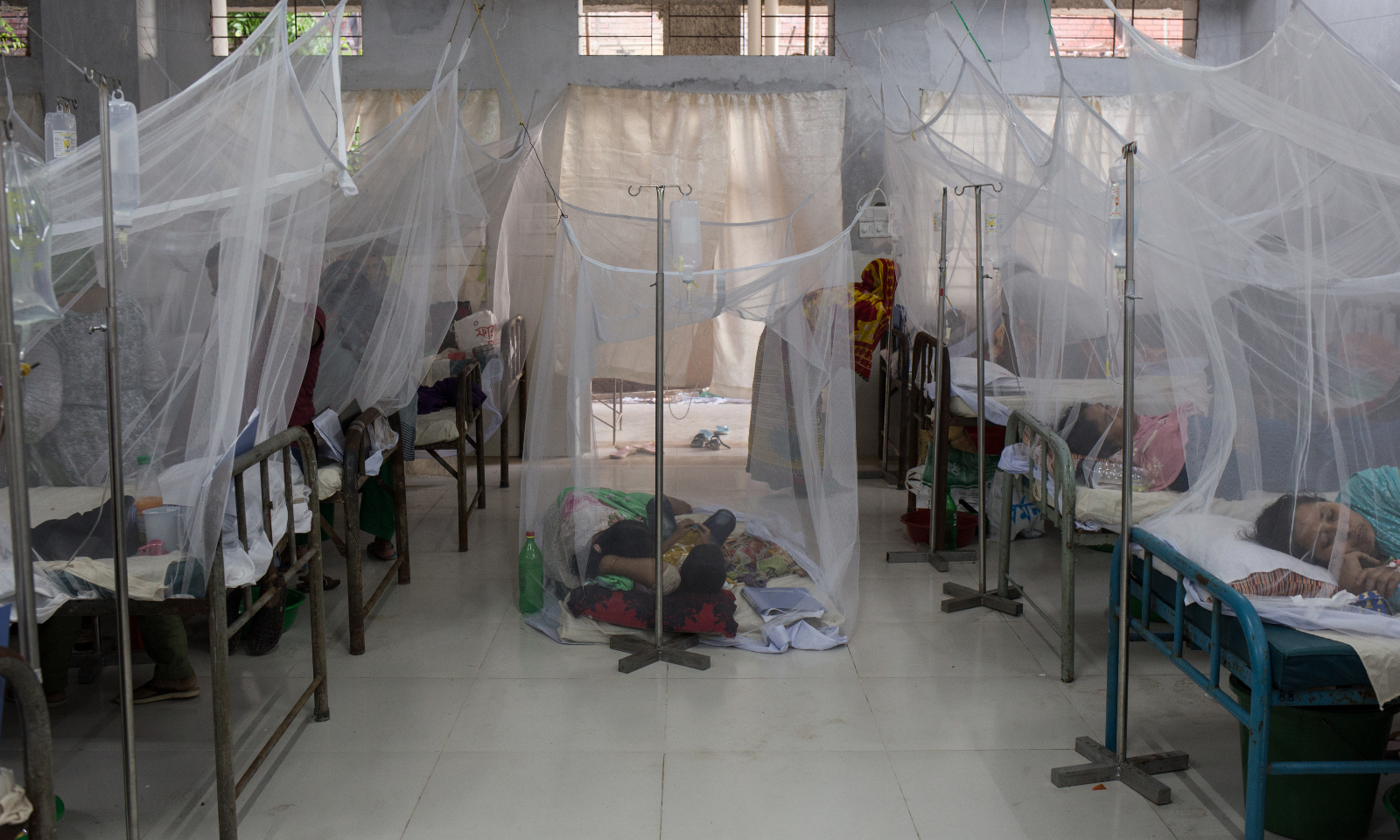
Carlson thinks the path forward builds on this work. Success hinges on predictive computer modeling, he said: research that can simulate disease spread and climate conditions and make predictions about how these patterns may change in the future. Predictive modeling doesn’t require researchers to track down mortality data counting every single person who died in a particular extreme weather event. The answer to the question of how many people have been killed by climate change, Carlson said, can be answered by developing a predictive modeling-based protocol for how researchers measure climate change-related deaths. He aims to gather the world’s leading climate and health experts together this year to build out exactly such a system. Getting researchers “baking to the same recipe,” he said, could ultimately produce an updated, more accurate climate mortality estimate.
Developing something resembling a universal climate mortality protocol won’t be simple, but it could accomplish what McMichael set out to do in the 2000s: furnish the public with a rough understanding of the full climate death toll, not 50 years into the future, but as it is happening right now. “If you don’t know how big the challenge is, you can justify not investing in the challenge,” said Kristie L. Ebi, a climate and health researcher at the University of Washington. Mortality data drives policy, and more policy is needed to protect the public from what’s coming — and what’s already here.
In the summer of 2022 — a cooler summer than the summer of 2023, which is on track to be eclipsed by the summer of 2024 — extreme heat in Europe caused over 60,000 deaths between the end of May and the beginning of September. Since early 2023, clouds of mosquitoes, spurred by unusual flooding and an intensifying monsoon season, have spread dengue fever across huge swaths of the world, infecting nearly 5 million people and causing more than 5,000 deaths. Last year’s extreme weather events killed 492 people in the U.S. — one of the countries that is best-equipped to deal with the fallout from extreme weather.
A deadly trend is underway. As McMichael put it in an open letter published just weeks before he died in 2014, “our mismanagement of the world’s climate and environment is weakening the foundations of health and longevity.” And yet, a very small proportion of the 4 million deaths caused by climate change so far, Carlson wrote in his commentary, “will have been recognized by the victims’ families, or acknowledged by national governments, as the consequence of climate change.” What would happen if people knew the true scope of the risk at hand? Carlson aims to find out.
This story was originally published by Grist with the headline Climate change has killed 4 million people since 2000 — and that’s an underestimate on Jan 30, 2024.
Romain Godin prides himself on being able to fix a wide variety of consumer devices. But recently, what was once a basic repair job for his Portland, Oregon-based business Hyperion Computerworks — replacing a cracked iPhone screen — has become needlessly complicated.
In the past, Godin would have replaced the broken screen on the spot with a working screen harvested from a dead phone, saving the customer from having to buy a brand new screen from Apple. But if Godin performs this simple procedure on one the latest models of iPhones, features such as True Tone, which adjusts screen brightness and color based on the ambient light conditions, won’t work anymore. What’s more, the phone will issue a repeated message warning the user that Apple cannot determine if the screen is genuine.
This is because many replacement iPhone parts, including screens, must now be “paired” with the phone using Apple’s proprietary software before they will function properly. And Apple’s “parts pairing” software will only recognize replacement parts purchased directly from Apple for that specific repair job — meaning an independent shop would have to order the part when the customer comes in, then potentially wait days for it to arrive. Meanwhile, the customer could go to an Apple Store and get their phone fixed with authorized parts on the spot. Godin says he’s losing business because of the hurdles a customer might face getting their iPhone fixed at his shop.
“It’s a lot of telling customers in advance, ‘We might run into this or that complication,’” Godin told Grist. “And the majority of the time, they don’t have us do the repair.”

As more and more states enact laws protecting consumers’ right to fix the devices they already have, or get them fixed at the repair shop of their choosing, tech titans are clashing over parts pairing. New York, Minnesota, and California all passed digital right-to-repair bills over the last two years, and repair advocates say Apple and trade associations it belongs to worked behind the scenes to weaken or block language that interfered with parts pairing. But while advocates expect Apple will fight new laws targeting the practice, Google came out in support of Oregon’s bill earlier this month — partly because of its ban on parts pairing. With tech giants now staking out opposing positions on parts pairing, repair advocates see a potential opportunity to gain ground.
Godin testified at a recent hearing of the Oregon Senate’s Energy and Environment Committee, which is considering a right-to-repair bill that explicitly bans parts pairing. If passed into law, the Oregon bill would represent the strongest legal rebuke yet of a practice that many independent repair shops see as an existential threat to their businesses, and that repair advocates say is fueling electronic waste and unnecessary resource consumption.
Restricting parts pairing is “the next step that likely needs to happen for right to repair to really gain a lot more traction,” said Colorado state representative Brianna Titone, who is sponsoring a digital right-to-repair bill in her state for the fourth time this year.
The right-to-repair movement is premised on the idea that when consumers have access to the parts, tools, and information needed to repair the devices they own, they can use those devices for longer. This both saves consumers money and reduces the environmental downsides of technology, which include electronic waste and the greenhouse gas emissions and resource consumption associated with manufacturing new products.
But parts pairing threatens to undermine the benefits of repair. Parts pairing refers to when companies use software to track their parts and control how they are used. Companies can assign spare parts serial numbers and program those parts to work properly only after their installation has been authenticated using the manufacturer’s specialized software. The practice isn’t exactly new: For years, agricultural equipment maker John Deere has restricted access to the software tools needed to install replacement parts on its tractors, while some automakers have engaged in “VIN burning,” or using software to limit the installation of replacement parts to a single vehicle. But in the consumer technology realm, parts pairing is becoming a greater concern for independent repairers, largely due to Apple’s growing use of the practice for its iPhone and laptops.
Apple claims its pairing process using the company’s “System Configuration” software tool is important for calibrating parts after their installation to ensure the best performance. But this kind of technology also represents a powerful tool for restricting repair. A person whose iPhone 15 battery dies can still go to an independent shop to get it swapped for a new one, or do the repair on their own. But in order to receive battery health updates and avoid nagging warning messages that the phone contains an unrecognizable part, that shop or individual needs to purchase the new battery from Apple, then pair it using System Configuration. This can cause repairs to take more time, in addition to driving up costs (while ensuring that Apple gets a cut).

Parts pairing is perhaps an even bigger problem for refurbishers, who use secondhand parts to keep costs down as they’re restoring old devices for resale. If a customer buys a refurbished laptop only to encounter warning messages about non-genuine parts, they may return it, said Marie Castelli, head of public affairs at the online refurbished device store Back Market.
“We have clients opening [return] tickets because they are afraid of messages” alerting them that the device cannot recognize a part like the screen, Castelli told Grist.
There’s an environmental cost to parts pairing, as well. When customers are steered away from used parts, those parts become e-waste. Meanwhile, demand for new parts rises, resulting in additional resource consumption and emissions tied to manufacturing. Right-to-repair is “about trying to keep things out of landfills; trying to reduce our dependence on all these minerals that go into all these parts,” Titone said. “And that’s really the big problem with parts pairing.”
The right-to-repair movement has made considerable progress forcing manufacturers to make spare parts, tools, and repair documentation available through a recently passed wave of state bills. But advocates say that Apple, and its trade association allies, have been largely successful in keeping bans on parts pairing out of the bills that have passed so far.
In New York, language that would have interfered with Apple’s internet-based system for pairing replacement parts was removed from the state’s right-to-repair bill after the trade association TechNet — which Apple is a member of — requested its deletion. In California, a coalition of lawmakers, repair advocates, and industry representatives negotiating the text of the state’s new right-to-repair law reached an agreement with Apple on the bill text prior to its approval by the Senate, according to David Stammerjohan, chief of staff for California state senator and bill sponsor Susan Eggman. After that agreement was reached, some coalition members wanted to add language that explicitly addressed parts pairing.
“We discussed it with Apple, which indicated they wanted to stick to the terms of the agreement,” Stammerjohn told Grist in an email. “Like all major bill negotiations, there were things industry would have liked in the bill that did not get in and things we would have liked in the bill that did not get into the final agreement.”
Minnesota’s new right-to-repair law does address parts pairing more explicitly. The law requires device manufacturers to make spare parts, tools, and documentation available to the public on fair and reasonable terms that cannot include any “requirement that a part be registered, paired with, or approved by the original equipment manufacturer or an authorized repair provider before the part is operational.” But while this may sound like a ban on parts pairing, Gay Gordon-Byrne, executive director of the repair advocacy organization Repair.org, worries that the language isn’t airtight enough to deter a manufacturer from locking down certain functions using software and then arguing its case before the state’s attorney general if anyone complains.
“I don’t have to be a legal expert to tell you I would expect that,” Gordon-Byrne told Grist.
Repair.org has written a template right-to-repair bill that includes provisions its members would like to see incorporated into actual legislation. For the 2024 legislative cycle, the organization updated its template bill language to more explicitly define, and prohibit, parts pairing. Some of that stronger language made its way into the bill now under consideration in Oregon, which states that manufacturers cannot use parts pairing to reduce the functionality or performance of a device or cause the device to display “unnecessary or misleading alerts or warnings about unidentified parts.”
This language is a key reason Google, whose more recent Pixel smartphones and Chromebook laptops would be covered under the latest version of Oregon’s bill, chose to throw its support behind the legislation, according to Stephen Nickel, who heads up repair operations at the company. In an interview with Grist, Nickel said that Google liked the “comprehensive” nature of the bill.

“It considers all aspects of repairability, and particularly … the issue of parts pairing,” he said, adding that Google is prepared to comply with “any and all” of the bill’s requirements.
Google’s newfound opposition to parts pairing, Titone said, suggests that the closed-door negotiations between lawmakers and device manufacturers are now spilling out into a “turf war” among tech companies vying for customers “in a very competitive market.”
“I think there is a market strategy that Google is trying to exploit right now,” she said. “Having [Pixel smartphone] repairability be really high is an edge.”
It remains to be seen whether Apple or others will fight the new Oregon bill or future ones that seek to restrict parts pairing. But all signs suggest a battle is brewing. Titone, the Colorado representative, said that when she spoke with Apple several months back concerning the right-to-repair bill she’s introducing this year, the company asked her to allow parts pairing in the text.
In response to Grist’s request for comment, an Apple spokesperson shared remarks that AppleCare VP Brian Nauman made at a White House repair event in October affirming the company’s commitment to a uniform federal repair law that “balances repairability with product integrity, usability, and physical safety.” The spokesperson declined to address criticisms of Apple’s parts pairing practices or share the company’s position on the anti-parts pairing provisions in the new Oregon bill or Minnesota’s recently passed law.
It isn’t just U.S. lawmakers seeking to limit parts pairing. The European Union is currently negotiating a new set of EU-wide rules on the right to repair that would make it easier and more cost-effective for consumers to repair devices versus replacing them. In November, the European Parliament adopted a draft version of the right-to-repair rules that, among other things, prohibits companies from using software to impede independent repair. The Parliament’s version of the rules must now be reconciled with draft versions proposed by the European Commission and European Council, with negotiations over the final text set to conclude in early February. But Castelli of Back Market, who is following the negotiations closely, said that “hopes are high in terms of what’s achievable” when it comes to parts pairing.
“Everyone wants to land on something and is open to negotiations,” she said.
This story was originally published by Grist with the headline Apple uses software to control how phones get fixed. Lawmakers are pushing back. on Jan 30, 2024.